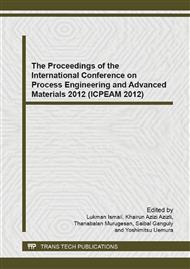[1]
C. Volzone, J. Rinaldi, J. Ortiga, N2 and CO2 Adsorption by TMA-and HDP-Montmorillonites, J. Mater. Res. 5 (2002) 475-479.
DOI: 10.1590/s1516-14392002000400013
Google Scholar
[2]
R. Yang, M. Baksh, Pillared clays as a new class of sorbents for gas separation, J. AIChE. 37 (1991) 679-686.
DOI: 10.1002/aic.690370506
Google Scholar
[3]
C. Volzone, J. Ortiga, O2, CH4 and CO2 gas retentions by acid smectites before and after thermal treatment, J. Mater. Sci. 35 (2000) 5291-5294.
Google Scholar
[4]
C. Volzone, J. Rinaldi, J. Ortiga, Retention of gases by hexadecyltrimethylammonium–montmorillonite clays, J. Enviro. Manag. 79 (2006) 247-252.
DOI: 10.1016/j.jenvman.2005.07.004
Google Scholar
[5]
C. Volzone, J. Ortiga, Influence of the exchangeable cations of montmorillonite on gas adsorptions. J. Proc. Safe. Enviro. Protec. 82 (2004) 170-174.
DOI: 10.1205/095758204322972807
Google Scholar
[6]
C. Volzone, J. Venaruzzo, J. Ortiga, M. Rueda, A. Ortiz Ricardi, Retención de SO2 en tobas y bentonitas modificadas por métodos físicos. Jornadas SAM/Conamet. in Simposio Materia. 6 (2003) 946-948.
Google Scholar
[7]
L. Ammann, F. Bergaya, G. Lagaly, Determination of the cation exchange capacity of clays with copper complexes revisited. J. Clay Miner. 40 (2005) 441-453.
DOI: 10.1180/0009855054040182
Google Scholar
[8]
G. Brown, The X-ray identification and crystal structures of clay minerals, (1961).
Google Scholar
[9]
S. Yariv, H. Cross, Organo-clay complexes and interactions, CRC Press, (2002).
Google Scholar
[10]
A. E. Elkhalifah, S. Maitra, M. A. Bustam, T. Murugesan, Effects of exchanged ammonium cations on structure characteristics and CO2 adsorption capacities of bentonite clay, J. Appl. Clay Sci. 83 (2013) 391-398.
DOI: 10.1016/j.clay.2013.07.016
Google Scholar
[11]
A. E. Elkhalifah, S. Maitra, M. A. Bustam, T. Murugesan, Thermogravimetric analysis of different molar mass ammonium cations intercalated different cationic forms of montmorillonite. J. Therm. Anal. Calor. 110 (2012) 765-771.
DOI: 10.1007/s10973-011-1977-8
Google Scholar
[12]
A. E. Elkhalifah, M.A. Bustam, T. Murugesan, Thermal properties of different transition metal forms of montmorillonite intercalated with mono-, di-, and triethanolammonium compounds, J. Therm. Anal. Calor. 19 (2013) 1-7.
DOI: 10.1007/s10973-012-2657-z
Google Scholar
[13]
S. Brunauer, P.H. Emmett, E. Teller, Adsorption of gases in multimolecular layers, J. Amer. Chem. Soc. 60 (1938) 309-319.
DOI: 10.1021/ja01269a023
Google Scholar
[14]
R. K. Kukkadapu, S.A. Boyd, Tetramethylphosphonium-and tetramethylammonium-smectites as adsorbants of aromatic and chlorinated hydrocarbons: effect of water on adsorption efficiency, J. Clays and Clay Miner. 43 (1995) 318-323.
DOI: 10.1346/ccmn.1995.0430306
Google Scholar
[15]
F. -C. Huang, J. -F. Lee, C. -K. Lee, H. -P. Chao, Effects of cation exchange on the pore and surface structure and adsorption characteristics of montmorillonite, J. Collo. Sur. A: Physicochem. Eng. Asp. 239 (2004) 41-47.
DOI: 10.1016/j.colsurfa.2003.10.030
Google Scholar
[16]
Y. Seki, K. Yurdakoç, Paraquat adsorption onto clays and organoclays from aqueous solution. J. Collo. Inter. Sci. 287 (2005) 1-5.
DOI: 10.1016/j.jcis.2004.10.072
Google Scholar
[17]
S. Burns, S. Bartelt-Hunt, J. Smith, A. Redding, Coupled mechanical and chemical behavior of bentonite engineered with a controlled organic phase, J. Geotech. Geoenviro. Eng. 132 (2006) 1404-1412.
DOI: 10.1061/(asce)1090-0241(2006)132:11(1404)
Google Scholar
[18]
Y. Xi, M. Mallavarapu, R. Naidu, Preparation, characterization of surfactants modified clay minerals and nitrate adsorption, J. Appl. Clay Sci. 48 (2010) 92-96.
DOI: 10.1016/j.clay.2009.11.047
Google Scholar


